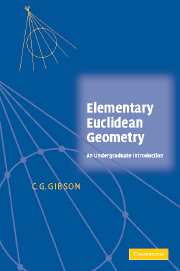Book contents
- Frontmatter
- Contents
- List of Figures
- List of Tables
- Preface
- Acknowledgements
- 1 Points and Lines
- 2 The Euclidean Plane
- 3 Circles
- 4 General Conics
- 5 Centres of General Conics
- 6 Degenerate Conics
- 7 Axes and Asymptotes
- 8 Focus and Directrix
- 9 Tangents and Normals
- 10 The Parabola
- 11 The Ellipse
- 12 The Hyperbola
- 13 Pole and Polar
- 14 Congruences
- 15 Classifying Conics
- 16 Distinguishing Conics
- 17 Uniqueness and Invariance
- Index
12 - The Hyperbola
Published online by Cambridge University Press: 06 July 2010
- Frontmatter
- Contents
- List of Figures
- List of Tables
- Preface
- Acknowledgements
- 1 Points and Lines
- 2 The Euclidean Plane
- 3 Circles
- 4 General Conics
- 5 Centres of General Conics
- 6 Degenerate Conics
- 7 Axes and Asymptotes
- 8 Focus and Directrix
- 9 Tangents and Normals
- 10 The Parabola
- 11 The Ellipse
- 12 The Hyperbola
- 13 Pole and Polar
- 14 Congruences
- 15 Classifying Conics
- 16 Distinguishing Conics
- 17 Uniqueness and Invariance
- Index
Summary
The geometry of the hyperbola has features in common with that of the real ellipse. Both types have a unique centre, two axes of symmetry, and two focal constructions. However, they differ fundamentally in one respect, namely that the hyperbola has two asymptotes. These represent a major feature of its geometry, providing the material for Section 12.1. The axes of a hyperbola are intimately related to the asymptotes, indeed they are their perpendicular bisectors. So far as parametrization is concerned, hyperbolas are analogous to ellipses. They cannot be parametrized by quadratic functions of a single variable, but do admit interesting rational parametrizations. For instance, the rectangular hyperbola has a rational parametrization very reminiscent of that for the circle. We use this to show how the geometry of the hyperbola underlies a standard technique of integration from foundational calculus.
Asymptotes
As we saw in Section 7.4 hyperbolas have two asymptotic directions, distinguishing them from ellipses and parabolas. Moreover, each asymptotic direction gives rise to a unique asymptote.
Lemma 12.1Any hyperbola H has exactly two asymptotes, namely the lines through the centre in the asymptotic directions.
Proof Since δ < 0 the quadratic terms in H factorize as UV, where U, V are lines through the origin in the asymptotic directions. Write H = UV + W + c, where W is linear and c is the constant term. By definition, asymptotes are parallel lines L = U + p, M = V + q not intersecting H.
Information
- Type
- Chapter
- Information
- Elementary Euclidean GeometryAn Introduction, pp. 114 - 124Publisher: Cambridge University PressPrint publication year: 2004
